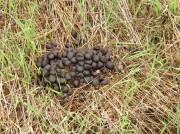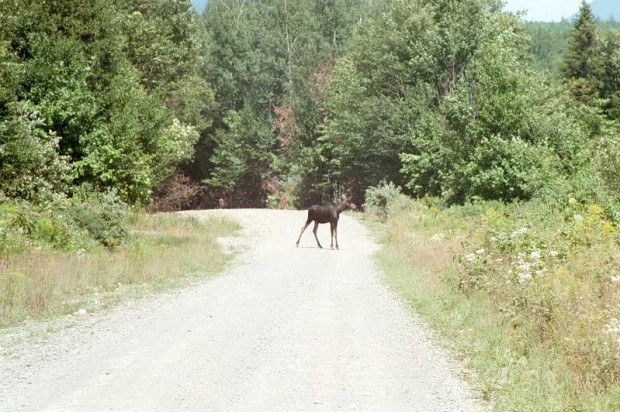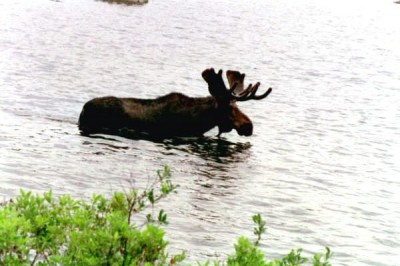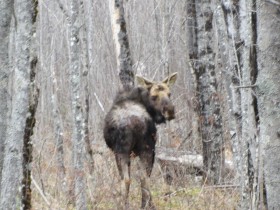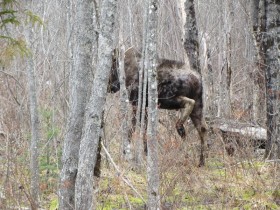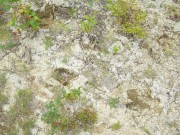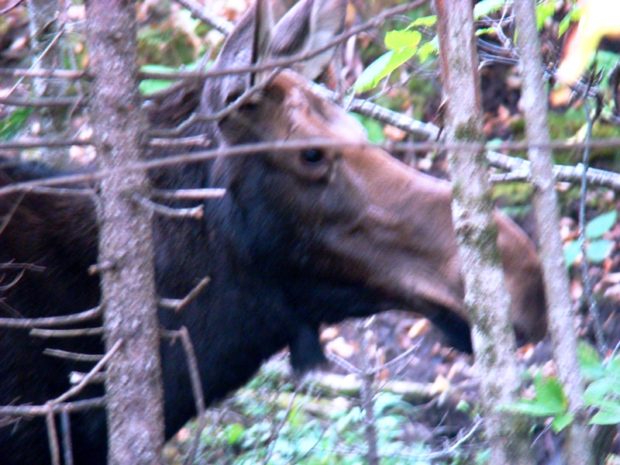
Most text from Jennifer Vashon, Wildlife Biologist. Maine Department of Inland Fisheries and Wildlife. Images, video and supplemental text by Jim Henderson. Along with Moose, the Encyclopedia features 15,000 images of lakes, farm buildings, barns, farmhouses, villages, cities, mountains, rivers,
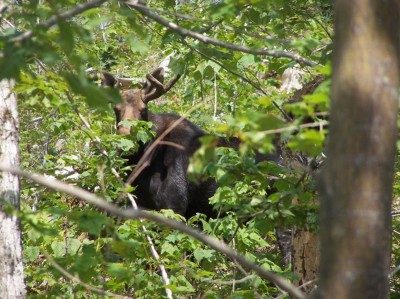
A Moose in its Leafy Habitat on the Carlo Col Trail in the Mahoosuc Range of Western Maine near the Appalachian Trail. (2007)
Did You Know…
♦ A lactating cow has the highest nutritional requirements of any moose and eats over 66 lbs. of browse a day?
♦ A cow may leave her calf periodically, but will return to it?
♦ A previous injury or poor nutrition can cause deformed antlers?
♦ Moose can move each ear independently?
♦ Moose can also move each eye independently?
♦ To see an object below them, a moose must tilt its head downward or twist its eyeball downward?
Hopefully, not too fast. Collisions with moose are a serious hazard in Maine, prompting signs along highways warning of crashes, often fatal to the driver, with this half-ton beast.
Physical Description
The Latin name for moose, Alces alces, means elk and in Europe and Asia moose are called elk. However, in North America, Alces species are called moose. Four subspecies of moose are recognized in North America.
The eastern or Taiga moose is the subspecies found in Maine.
During Maine’s fall hunting season, the average adult cow weighs 600 lbs (dressed) and the average adult bull weighs 800 lbs (dressed). Large bulls weigh over 1000 lbs, dressed. The total length of a moose is about 9 feet and height measured at the shoulder is about 6 feet. The front hoof width is about 5 inches for a prime bull, just under 4 inches for a cow, and just under 3 inches for a calf. A cow has a brown face and dark body and a bull has a black face.
Both cows and bulls have “bells,” skin flaps found on the neck. A cow’s bell looks more like a tuft of hair, whereas a bull’s bell is larger and rounder. Some bulls may have an additional tuft of skin extending below the bell, but it is believed that this extension freezes off. A bull’s antlers spread rarely exceeds 65 inches and a spread of 55 inches is considered good. Antlers on cows are extremely rare. Calves may have small buds by late September, yearlings may have spikes or small forks, and palms typically first develop in 2 and 3 year old bulls. Maximum antler development is obtained at age 5 and declines when bulls are in their teens.
A Moose Story
There are probably more moose stories than moose in the woods. Here’s one from John Steinbeck from his Travels with Charlie in Maine during 1960:
In the silver chill of the Maine afternoon, as I bucketed and lumbered over the pitted surface of a wood road, I saw four lady mooses moving with stately heaviness across my bow. [He then blows a cow calling horn he had installed in his truck.] The ladies, who were on the point of disappearing into the forest, heard the sound, stopped, turned, and then came for me with gathering speed and with what looked to me like romance in their eyes–but four romances, each weighing well over a thousand pounds! And much as I favor love in all its aspects, I trod my accelerator and got the hell out of there fast.
Natural History
Habitat
Bulls and cows use somewhat different habitats during the summer, which is a tradeoff between cooler temperatures for bulls and the requirements for raising calves. Bulls are typically found at higher elevations in mixed and hardwood stands, where food supply is less available, but shading provides cooler temperatures.
Cows are found at lower elevations in regenerating stands and adjacent softwoods, because food is more concentrated. Shallow waterways with underwater grasses, water lilies and other plants are attractive eating places. This concentrated food source limits the amount of time cows spend feeding, which limits calves vulnerability to predators.
Moose typically winter at higher elevations where more hardwood browse is available, and they often feed in regenerating stands. Mature softwood is used as cover when snow depth exceeds 3 feet.
Food Habits
Moose subsist on browse, the leaves and twigs of woody plants. Willow, aspen, birch, maple, pin cherry, and mountain ash are important, high quality browse utilized year round by moose. Because leaves are absent from hardwoods in the winter, balsam fir is an important winter food for moose. However, moose can not survive on balsam fir alone, because it has lower nutritional value. Fire, wind throw, insects, and forest practices, such as clear cutting, promote disturbance and regrowth of these important forage trees.
Sodium is also important to moose. Aquatic plants, such as pondweed and water lily, have a higher sodium content than woody vegetation and are an important part of a moose’s diet. As a result, moose have reduced the number of aquatic plants in much of northern Maine. Natural salt licks are rare in Maine, so moose are often seen along roads (as the one near Katahdin Iron Works at left) using the salt runoff as an artificial salt lick.
Reproduction
The breeding season for moose begins in late September and last into early October. Cows may produce their first calf when they are two, and most produce a calf by age 3. Each May, cows give birth to 1 to 2 calves. Cows rarely have more than 2 calves and young cows rarely have twins. A cow’s nutritional condition determines the number of calves born and when a cow first breeds. Moose continue to breed into their teens, but are less productive. Calves remain with their mother for one year and are driven off shortly before the next calf is born. Bulls are able to breed as yearlings, but most do not breed until they are older and can compete with other larger bulls.
Survival
Moose die from a variety of causes: legal and illegal harvest, road kills, other accidents (drowning, falls, etc.), predation, disease, starvation, and old age. Harvest and road kills account for 2,000 to 2,500 moose deaths a year. Predation of adult moose is low, because predators capable of killing adult moose are rare or absent from Maine. Black bears, which are common in Maine, are potential predators of moose calves.
Three parasites can cause mortality in moose in Maine: brain worm, winter tick, and lung worm. Moose infected with brain worm almost always die, but winter tick and lung worm infestations rarely kill moose. Sarcoptic mange can cause severe itching, crusting and inflammation of the skin. A highly contagious disease, it is mostly transmitted by direct contact.
Longevity
The average life expectancy is 8 years for a cow and 7 years for a bull. Moose may live into their late teens, but rarely live past 20.
Historical Management in Maine
Before Europeans arrived, moose were plentiful in Maine. Indians hunted them for subsistence, with only crude tools and methods. With the introduction of the musket, used first by the colonists and later by the Indians, Moose we we taken in ever increasing numbers.
By the mid-17th century, the moose population was thinning out. By the end of the 18th century, colonial historian James Sullivan said of Maine “the moose, a monstrous large animal, has been there in former days, but It is rare to see one at the present time.”*
Distribution and Population
According to writings of early explorers, moose were plentiful in New England during the 1600s. By the early 1900’s, moose populations in Maine had declined to an estimated 2,000. This decline was mostly attributed to unrestricted hunting. Clearing forestland for farming and increased incidence of brainworm attributed to increasing deer populations also contributed to their decline. Deer are host or carriers of brainworm without suffering any ill effects. During the 1900’s, laws protecting moose from excessive hunting, and improving habitat conditions, allowed the moose population to increase. The moose population is currently estimated at 29,000.
Season Changes
Prior to 1830, there were no laws restricting the harvest of moose. Moose could be hunted statewide, all year, without a bag limit. In 1830, the first law established an open season of 2 months. Over the next 14 years, from 1830-1874, the season length ranged from 2 to 8 months. Moose hunting was not allowed from 1875-1879. In 1880, the moose season was reopened. A bag limit was first established in 1889, which limited each hunter to one bull.
From 1889-1915, the season length varied from 1 to 3 months. In 1915, the moose season was closed statewide. The season was reopened in 1919 for a short 11 day season with a 1 bull bag limit. The season continued to be closed and reopened periodically from 1920-1936. When the season was open, only one bull moose per hunter could be harvested during a 6 day season. In 1935, the season was reduced to 3 days. Then in 1936, the moose season was closed and remained closed until 1980. During this 54 year season closure, several bills were introduced to reestablish a moose season.
In 1979, a moose hunting bill passed both houses and was signed into law. This law allowed the Maine Department of Inland Fisheries and Wildlife to issue up to 700 permits to Maine resident hunters in 1980. A 6 day season was set during the last week of September 1980 and was restricted to an area north of the Canadian Pacific Railroad. A bag limit of one moose of any sex or age was allowed.
Since 1980 a lottery has been introduced for licenses. For the latest information on licensing and the moose population visit the Maine Department of Inland Fisheries and Wildlife at http://www.maine.gov/ifw/wildlife/species/moose/, from which this article was obtained on March 4, 2011. It has been condensed and edited for inclusion here.
More Videos!
Additional resources
* Cronin, William. Changes in the Land: Indians, Colonists, and the Ecology of New England. New York. Hill and Wang. 1983. p. 105.
Banasiak, Chester, et al. Big Game. Augusta, Me. Maine Department of Inland Fisheries and Wildlife, Divisions of Planning and Coordination and Wildlife. 1979.
Hidden Hazards [videorecording]: Dangers of Moose/Car Collisions. Waterville, Me. URSUS Productions; Augusta, Me. Distributed by Maine Department of Transportation. c2000. Bangor Publis Library; Maine State Library; and libraries of the University of Maine at Farmington, Fort Kent, Machias, and Presque Isle]
Maine. Department of Inland Fisheries and Wildlife. Game Division. Moose Studies: Final Report. Augusta, Me. The Department. 1975. [Maine State Library]
Silliker, Bill. Maine Moose Watcher’s Guide. South Berwick, Me. R. L. Lemke Corp. 199?. [University of Maine, Raymond H. Fogler Library, Special Collections; Maine State Library]
Steinbeck, John. Travels with Charley, pp. 72-73.


